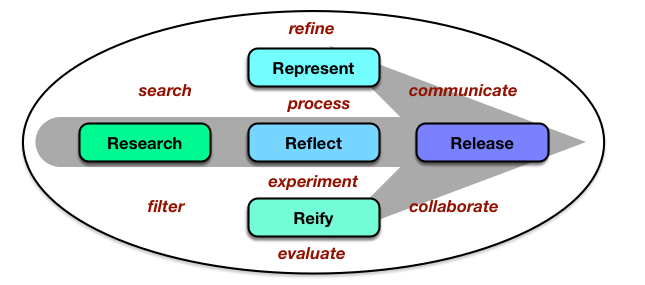As I’ve reported before, I started mind mapping keynotes not as a function of filling the blog, but for listening better. That is, without the extra processing requirement of processing the talk into a structure, my mind was (too) free to go wandering. I only posted it because I thought I should do something with it! And I’ve realized there’s another way I leverage cognitive overhead.
As background, I diagram. It’s one of the methods I use to reflect. A famous cognitive science article talked about how diagrams are representations that map conceptual relationships to spatial ones, to use the power of our visual system to facilitate comprehension. And that’s what I do, take something I’m trying to understand, some new thoughts I have, and get concrete about them. If I can map them out, I feel like I’ve got my mind around them.
I use them to communicate, too. You’ve seen them here in my blog (or will if you browse around a bit), and in my presentations. Naturally, they’re a large part of my workshops too, and even reports and papers. As I believe models composed of concepts are powerful tools for understanding the world, I naturally want to convey them to support people in applying them themselves.
Now, what I realized (as I was diagramming) is that the way I diagram actually leverages cognitive overhead in a productive way. I use a diagramming tool (Omnigraffle if you must know, expensive but works well for me) to create them, and there’s some overhead in getting the diagram components sized, and located, and connected, and colored, and… And in so doing, I’m allowing time for my thoughts to coalesce.
It doesn’t work with paper, because it’s hard to edit, and what comes out isn’t usually right at first. I move things around, break them up, rethink the elements. I can use a whiteboard, but usually to communicate a diagram already conceived. Sometimes I can capture new thinking, but it’s easy to edit a whiteboard. Flip charts are consequently more problematic.
So I was unconsciously leveraging the affordances of the tool to help allow my thinking to ferment/percolate/incubate (pick your metaphor). Another similar approach is to seed a question you want to answer or a thought you want to ponder before some activity like driving, showering, jogging, or the like. Our unconscious brain works powerfully in the background, given the right fodder. So hopefully this gives you some mental fodder too.
 The core is the 5 R’s: Researching the opportunities, processing your explorations by either Representing them or putting them into practice (Reify) and Reflecting on those, and then Releasing them. And of course it’s recursive: this is a release of my representation of some ideas I’ve been researching, right? This is very much based on Harold Jarche’s
The core is the 5 R’s: Researching the opportunities, processing your explorations by either Representing them or putting them into practice (Reify) and Reflecting on those, and then Releasing them. And of course it’s recursive: this is a release of my representation of some ideas I’ve been researching, right? This is very much based on Harold Jarche’s